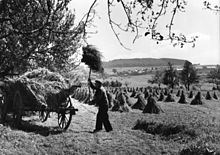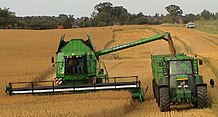Grain harvest
The grain harvest refers to the harvest of grains .
The most common types of grain in Central Europe are barley , rye , wheat , oats and maize . Triticale , a cross between wheat and rye, has also been grown since around 1985 .
Procedure
Earlier
For thousands of years, the grain harvest was already carried out by hand using a sickle , sight or scythe while the grain was maturing . The mown stalks of grain were tied into sheaves ; Several sheaves were then placed against each other on the field as a squat, house, doll or staircase for further drying and ripening. The mowing work was usually done by men, whereas tying the sheaves was done by women. The sheaves were then brought to the barn and, after further storage, threshed either by hand or later by a threshing machine . Sometimes the threshing also took place directly in the field; if the threshing could not be carried out promptly, the sheaves were placed on fines to protect against the weather and vermin . With the development of the mower to the mid-19th century needlework while mowing the grain was very gradually mechanized, the development went this way to the same mowing and sheaves binding harvester . However, depending on various factors such as the size of the company and the geographical location, the use of the more simply constructed grain mower or the grass mower modified by means of a hand rest continued to take place parallel to the use of the mower binders. For mowing the fields to avoid grain loss and malfunction of the machines, d. H. the mowing of the first free strip around the field, sickle, sight or scythe were also used.
today
Today, however, the grain harvest in Central Europe takes place almost exclusively with the help of combine harvesters . These mow the grain in one operation, thresh it, clean the threshed grain and either deposit the straw as a swath on the field or chop and distribute it on the field for better incorporation and rotting. In contrast to earlier methods, the combine harvester requires dead-ripe grain; the narrower time window to harvest at dead maturity due to the higher risk of spoilage or outgrowth of the grain is completely offset by the enormous power of the harvesting process. The almost complete displacement of the older harvesting methods by the combine took place in Germany around the 1960s.
Not only the farmers are involved in the grain harvest, the most important machine, the combine harvester, including the driver, is often provided by a contractor.
The beginning of the harvest is determined by the farmer based on experience. The moisture content of the grain is an important parameter for the right time . If the moisture is below 15% water, the harvesting conditions are ideal. In unfavorable weather periods, however, the grain must be threshed with a higher proportion of moisture. In this case, the grain must be temporarily cooled to +7 ° C, dried afterwards or otherwise protected from spoilage . If the grain is to be used as animal feed , it can be made into a pulp without artificial drying, among other things through the use of the preservatives propionic acid or urea , oxygen deprivation due to inhalation through the harvested material, even when stored in gas-tight silos or ensiling (lactic acid fermentation) with the addition of water mixed grain can be preserved.
Grain is grown for very different purposes. A very large part is bought by the feed industry, a further large part remains in the farms as feed for their own livestock.
Harvest quantities in Germany
(including grain maize and corn cob mix )
- 2000: 45.3 million tons
- 2001: 49.7 million tons
- 2002: 43.4 million tons
- 2003: 39.4 million tons
- 2004: 51.1 million tons
- 2005: 50.0 million tons
- 2006: 43.5 million tons
- 2007: 40.6 million tons
- 2008: 50.1 million tons
- 2009: 49.8 million tons
- 2010: 43.8 million tons
- 2011: 41.1 million tons
- 2012: 45.4 million tons
- 2013: 47.1 million tons
- 2014: 51.8 million tons
- 2015: 48.2 million tons
- 2016: 45.5 million tons
- 2017: 45.3 million tons
- 2018: 38.0 million tons
- 2019: 44.7 million tons
literature
- Schlipf: Handbook of Agriculture . 13th edition (1898) and 32nd edition (1958), Paul Parey, Berlin (and Hamburg), reprinted in one volume by Manuscriptum Verlagsbuchhandlung, ISBN 3-933497-77-9 .
- Schweigmann: The agricultural machines and their handling . 1st edition, Verlag Dr. Pfanneberg, Gießen 1955, reprinted by Bulldog Press, Limburg / Lahn, ISBN 3-9803332-1-3 .
Individual evidence
- ↑ Heinz-Peter Mielke, Niederrheinisches Freilichtmuseum Grefrath (museum guide), 1st edition, Grefrath, 1997, ISBN 3-932793-00-5 , p. 170
- ^ Horst Eichhorn (editor): Landtechnik . 7th edition, Ulmer, Stuttgart 1952/1999, ISBN 3-8001-1086-5 , p. 262 ff.
- ↑ Special Harvest and Quality Determination (BEE) 2016. Accessed on August 19, 2019 .
- ↑ BMEL harvest 2017 - quantities and prices. Retrieved August 19, 2019 .
- ↑ Special Harvest and Quality Determination (BEE) 2018. Accessed on August 19, 2019 .
- ↑ Harvest report 2019. Accessed on May 20, 2020 .
Web links
- From sickle to combine harvester (PDF; 533 kB)




